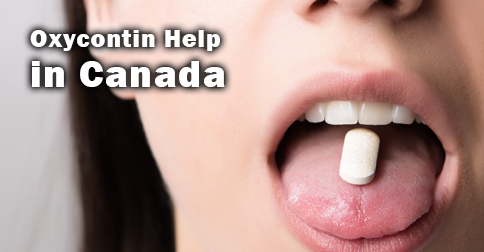OxyContin Help in Canada
 Even using the most conservative estimate, 50-55,000 Canadians are opioid dependent, says the Canadian Executive Council on Addictions. Similarly, the Quebec surveillance network documents a shift among opioid-dependent individuals from heroin to prescription drugs. This will not, writes Dr. Roger Ladouceur in Canadian Family Physician, come as a surprise to anyone familiar with OxyContin.
Even using the most conservative estimate, 50-55,000 Canadians are opioid dependent, says the Canadian Executive Council on Addictions. Similarly, the Quebec surveillance network documents a shift among opioid-dependent individuals from heroin to prescription drugs. This will not, writes Dr. Roger Ladouceur in Canadian Family Physician, come as a surprise to anyone familiar with OxyContin.
Perhaps your doctors prescribed OxyContin when other painkillers stopped working. Although six million people a year take OxyContin, USA Today calls it a “prescription for trouble.” The US National Institute of Health recently reported that 23.9 million American adults —over 9 percent of the population—overused an addicting medication in the past month.
OxyContin is a controlled-release version of oxycodone hydrochloride. Like any narcotic intended for extended pain relief, it can quickly become addicting. Those addicted to OxyContin often crush the tablets, and then inject or snort them to get the drug into the bloodstream all at once. That increases your risk of addiction and can be fatal, even the first time you try it.
Opiate overdoses are rising sharply across Canada, thanks to an increase in prescription drug use, CBC news reports, quoting the Canadian Drug Policy Coalition. “It’s a national issue,” says Donald MacPherson, executive director of the Canadian Drug Policy Coalition. Over-prescribing opiates means “there’s a lot of prescription opioids out there in the market,” he says.
Doctors need to take more responsibility for educating people about the dangers, MacPherson writes. The more you use OxyContin, the more you need, which leads to addiction. Symptoms of addiction can include flabby muscles, shallow breathing leading to respiratory arrest, or a drop in your heart rate and blood pressure, which can bring on a coma and even death. Science Daily reports that “legal drugs such as OxyContin now kill more people than heroin and cocaine combined.” Dr Ladoceur predicts that nearly 10% of those who take it for pain become addicted.
Furthermore, there are risks with trying to detox [from non-prescription drugs] by substituting prescription drugs like Oxycontin, admits Dr. Michael Trew, Alberta’s chief addiction and mental health officer. Opiate users lose their tolerance to their drug quickly when they stop using it, he says; so if they relapse and go back to taking the same dosage, it could be enough to kill them.
Unfortunately, OxyContin withdrawal can painful. Withdrawal symptoms are like heroin withdrawal, and may include sweating, heart spasms, increased blood pressure, nausea, dehydration, abdominal cramps, trembling, weakness, muscle ache, diarrhea, vomiting, restlessness, leg spasms, insomnia, and mood disturbances such as irritability and thoughts of suicide.
So “going it alone” rarely works. Yet getting treatment in Canada isn’t easy. One mother in Calgary calls finding funded treatment for her own son “a constant struggle”; alternatively, three months at a local private facility would cost the family $33,000 (CAN).
“Physicians … in both cities and in rural areas, struggle with getting … treatment for their patients,” reports Dr. Susan Ulan, assistant registrar with the College of Physicians and Surgeons of Alberta. “We know that many patients … [especially in rural areas look elsewhere] to access treatment.”
There is a better answer waiting for you, just across the border.
Short wait, proven results, one-fourth the cost…
The Rapid Drug Detox (RDD) Center, in Troy, Michigan, has a better way. The RDD Center’s Anesthesia OxyContin detox is a proven procedure that effectively reduces the pain and discomfort associated with conventional OxyContin detox.
Rapid anesthesia detoxification (The RDD Method™) is a medical procedure that “cleans” the OxyContin drug from your brain’s opiate receptors. It even eases you successfully through the “rebound anxiety” that often accompanies detoxification.
Instead of a difficult, several-week withdrawal period, RDD (rapid drug detox) treatment takes 3 days and eliminates most of withdrawal symptoms.
The actual procedure takes about an hour. After a brief, painless series of tests, you’ll be admitted to the operating room (O.R.). There, an experienced, board certified anesthesiologist gives you a medication to relax, and then administers a light, general anesthesia. While you rest comfortably, a team of experienced doctors “scrubs” the opiate receptors in your body, using an infusion of intravenous medications.
Once the OxyContin is removed from your receptors, the worst of the withdrawal is over. And you’ve slept through it all.
After the procedure, you recover under direct medical supervision. The RDD team of experienced medical professionals monitors your vital signs and your overall physical and mental reactions. In the days that follow the procedure, you may sleep more than usual.
Administered by professionals as part of a long-term drug-addiction recovery strategy, the RDD Method™ has proven to be significantly more effective than older methods.
Will it work for you? The answer starts with a phone call. When you call, you get to talk to a professional nurse or an experienced intake coordinator. The call is toll-free. Click here now to contact the Rapid Drug Detox Center or call Rapid Drug Detox at 1-866-399-2967 now and take the first step toward a lifetime of freedom from addiction.
The RDD Center makes sure that nurses are on call 24 hours a day, 7 days a week, and that the Center’s knowledgeable, licensed medical professionals are always available to answer all of your questions.

